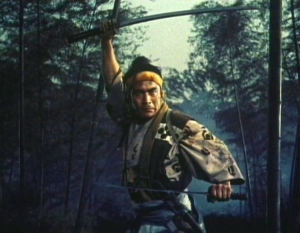Samurai II: Duel at Ichijoji Temple
Rating: *****
Origin: Japan, 1955
Director: Hiroshi Inagaki
Source: Criterion Collection DVD

For a movie less than two hours long, there’s an awful lot going on here. As the second film in a trilogy, this one has to do the heavy lifting of supporting the central arch of the hero’s character development, as well as shuffling the story forward and setting up the climactic final movie, and it does all this with clarity, economy, and finesse. And that’s important, because this is the part of the story where the legendary Musashi Miyamoto, played once again by Toshiro Mifune, must evolve from an angry and arrogant bully into a humble and honorable samurai warrior.
As far as Musashi is concerned, the story is a succession of fights separated by encounters with surprising mentors—a caustic old monk, an accomplished geisha, a reverent sword-polisher—who teach him how to look within to find himself. For the rest of the ever-burgeoning cast, it’s a frantic dance of deceit, adoration, conspiracy, rape, greed, ambition, calculation, and murder, in a carefully orchestrated flow of short, sharp scenes that keep the story moving so deftly you can almost ignore its series of mind-boggling coincidences. All the characters introduced in the first movie return to be joined by an equal number of new faces, most of whom make it to the end of this film with their plots still unresolved. The most important new character is Kojiro Sasaki (Koji Suruta), a wry and cynical young swordsman who seems to dog Musashi’s every footstep, showing up whenever there’s trouble, sometimes fomenting it, sometimes defusing it, but always with an eye toward how everything points toward an inevitable showdown with Musashi.
Speaking of showdowns, there’s a lot of fighting in this entry, much more than in the previous picture, and director Inagaki shows himself to be a master of the form. But of all the combats in the film, significantly only the first and last are shown from beginning to end, because they bookend Musashi’s character arc; all other fights are only partially depicted, mere links in the chain of the story’s progress.
The movie opens on the first duel, in which Musashi has been challenged by Baiken, a master of the kusari gama (chain and sickle). Musashi, facing an unfamiliar weapon, is unsure of himself, gets caught by the chain, and wins only through audacity and desperation. An aging monk who witnesses the duel tells him disapprovingly that though victorious, he is no samurai, as he didn’t win by art or skill, only sheer force. “You are decidedly too strong,” he says.
Only as events unfold does Musashi begin to glimpse what the monk means. He gets into a protracted squabble with the many swordsmen of the Yoshioka fencing school, whom he repeatedly defeats while demanding a match with the young samurai who has inherited the school’s mastery—a duel which is always denied him, because the Yoshioka students secretly fear their master is no match for Musashi. They keep trying to kill him in failed or mistaken ambushes, and the wrong people die. Meanwhile all the secondary characters pursue their agendas of love and avarice in and around this feud, and hostilities sharpen and harden.
Finally a duel between Musashi and Seijuro Yoshioka (Akihito Hirata) is set for dawn at Ichijoji Temple—but once again the master is diverted, and some eighty of his students set an ambush for Musashi. Forewarned by Akemi, one of the three women pining for his affections, Musashi defies the ambushers and then battles the lot of them in a magnificent fighting retreat, carefully choosing his terrain so they can only come at him a few at a time. After dropping two dozen adversaries, Musashi eventually breaks away into the forest, nearly exhausted, only to be confronted by Seijuro at last. Musashi can barely contain his rage: after taking the measure of his opponent, he defeats Seijuro in a single pass, but then refrains from killing him as all his recent life lessons combine to restrain his hand. And then all the elements are set up to perfection for resolution in the final film.